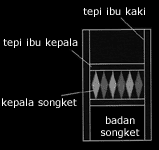Design Structure & Pattern Arrangements
Before getting to understand what basically comprises a songket
design and pattern, it is best to know that the Malay artists
and craftspersons are very aware of space presentation and balance.
Instinctively, harmony and scheme of patterning play very important
roles in the designing of the songket. Although the current weavers
rarely draft their songket patterns before they weave, they already
have old songket sarongs to copy. In this way, many of the traditional
motifs and patterns have been preserved. This does not mean that
weavers of the present generation are not creative or innovative.
New motifs and patterns have been created but the original structure
and artistic harmony of the songket have been faithfully preserved.

|
The basic structure of the kain songket or songket sarong
consists of:
(a) Badan kain - the 'body' or the main part of the cloth
(b) Kepala kain - the 'head' or the panel of the cloth
(c) Kaki kain - the 'foot' or the border of the cloth |
Other subsidiary areas are borders that run parallel vertically
or lengthwise accompanying the badan kain and the kepala kain.
These side borders are called kapit or pengapit. The end parts
of the cloth is called punca and the extremities of the punca
called kaki punca. If you see small patterns running along the
border you have actually identified the kendik. One last term
that you need to know is the tanah kain or 'ground' of the cloth,
which in fact refers to the background colour of the cloth itself.

